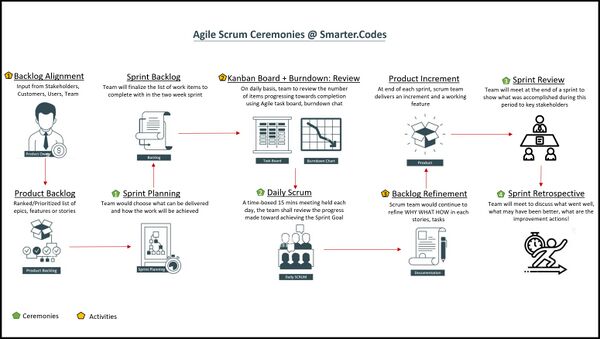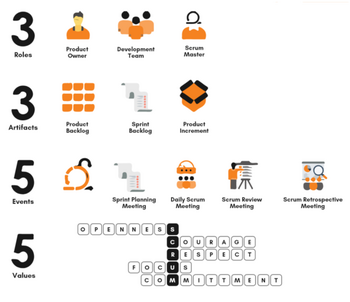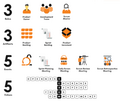Public:Agile Ceremonies: Difference between revisions
imported>Anand (Created page with "Agile Workflow: Product Backlog Alignment: 1. PO on regular basis to add customer ideas, feature requests, defect incidents, internal team’s input to the product roadmap 2....") |
m (Anand Sathiyaseelan moved page Agile Ceremonies to Public:Agile Ceremonies) |
||
| (14 intermediate revisions by one other user not shown) | |||
| Line 1: | Line 1: | ||
Agile | Agile ceremonies are recurring events that enable teams to plan, collaborate, and review their work. The most common ceremonies in Agile methodology are Sprint Planning, Daily Stand-up, Sprint Review, and Sprint Retrospective. These ceremonies help to ensure alignment, transparency, and continuous improvement throughout the development process. | ||
[[File:Agile_Ceremonies.jpg|alt=Agile Ceremonies|600px|center|thumb|Agile Ceremonies]] <br> | |||
Product Backlog | '''<u>Product Backlog Alignment</u>''': | ||
[[File:Agile calendar.png|alt=Agile Calendar|350px|right|thumb|Agile Calendar]] | |||
# PO on regular basis to add '''''customer ideas''''', '''''feature requests''''', '''''defect incidents''''', '''''internal team’s improvement input''''' to the '''<u>product roadmap</u>''' | |||
# PO to analyze the competitors, technology trends, market opportunity, strong user demand and '''<u>add or move the item from roadmap to product backlog</u>''' | |||
# PO to collaborate closely with Key Stakeholders: Sponsors, Clients on Day 4 of current sprint (Ex: Sprint 1) and present them with the product backlog items | |||
# Stakeholders to discuss and provide recommendation of their priority for the product backlog items | |||
# Product owner (served by Scrum Master) would reassess, reprioritize and prepare the final list of product backlog items to be considered for the upcoming sprint (Ex: Sprint 2) and create the sprint backlog | |||
'''<u>Product Backlog Refinement</u>''': | |||
# Product owner to work upon the acceptance criteria for the finalized product backlog items | |||
# Scrum master to work upon the Definition of Done | |||
# Product owner and scrum master to have refinement session 1 on Day 7 with the agile team and walk them through the acceptance criteria and definition of done | |||
# PO to remove, split epics into user stories based on changing needs | |||
# PO to initiate a fast-paced Product Design Sprint in Sprint 1 to develope wireframe, prototype for the sprint backlog items planned in the upcoming Sprint 2 | |||
# PO to demostrate the prototype with the stakeholders/clients and get it approved | |||
# Product owner and scrum master to have refinement session 2 on Day 9 with the agile team and walk them through the revised acceptance criteria and definition of done and mark them as ‘Ready’ | |||
'''<u>Sprint Planning</u>''': | |||
# SM to facilitate the Sprint planning ceremony with the Agile team | |||
# PO to present the Sprint backlog as “Input” to the ceremony and explain the “What” ''(describes the objective(or goal) of the sprint and what backlog items contribute to that goal. Developers need to understand how they can or cannot deliver that goal)'' | |||
# Developers to discuss the “How” ''(plan the work necessary to deliver the sprint goal and negotiate on the capacity and efforts)''The “Outcome” of the Sprint Planning is the agreed Sprint Backlog that describes the sprint goal and how the team will start working towards that goal | |||
[[File:3355 Scrum.png|alt=3355 Principle|350px|right|thumb|3355 Principle]] | |||
'''<u>Gallery</u>''': | |||
<gallery> | |||
File:3355 Scrum.png|3355 Scrum Principle | |||
File:Agile calendar.png|Agile Calendar | |||
</gallery> | |||
[[Category:Project Management]] | |||
Latest revision as of 15:07, 13 December 2023
Agile ceremonies are recurring events that enable teams to plan, collaborate, and review their work. The most common ceremonies in Agile methodology are Sprint Planning, Daily Stand-up, Sprint Review, and Sprint Retrospective. These ceremonies help to ensure alignment, transparency, and continuous improvement throughout the development process.

Product Backlog Alignment:

- PO on regular basis to add customer ideas, feature requests, defect incidents, internal team’s improvement input to the product roadmap
- PO to analyze the competitors, technology trends, market opportunity, strong user demand and add or move the item from roadmap to product backlog
- PO to collaborate closely with Key Stakeholders: Sponsors, Clients on Day 4 of current sprint (Ex: Sprint 1) and present them with the product backlog items
- Stakeholders to discuss and provide recommendation of their priority for the product backlog items
- Product owner (served by Scrum Master) would reassess, reprioritize and prepare the final list of product backlog items to be considered for the upcoming sprint (Ex: Sprint 2) and create the sprint backlog
Product Backlog Refinement:
- Product owner to work upon the acceptance criteria for the finalized product backlog items
- Scrum master to work upon the Definition of Done
- Product owner and scrum master to have refinement session 1 on Day 7 with the agile team and walk them through the acceptance criteria and definition of done
- PO to remove, split epics into user stories based on changing needs
- PO to initiate a fast-paced Product Design Sprint in Sprint 1 to develope wireframe, prototype for the sprint backlog items planned in the upcoming Sprint 2
- PO to demostrate the prototype with the stakeholders/clients and get it approved
- Product owner and scrum master to have refinement session 2 on Day 9 with the agile team and walk them through the revised acceptance criteria and definition of done and mark them as ‘Ready’
Sprint Planning:
- SM to facilitate the Sprint planning ceremony with the Agile team
- PO to present the Sprint backlog as “Input” to the ceremony and explain the “What” (describes the objective(or goal) of the sprint and what backlog items contribute to that goal. Developers need to understand how they can or cannot deliver that goal)
- Developers to discuss the “How” (plan the work necessary to deliver the sprint goal and negotiate on the capacity and efforts)The “Outcome” of the Sprint Planning is the agreed Sprint Backlog that describes the sprint goal and how the team will start working towards that goal

Gallery:
-
3355 Scrum Principle
-
Agile Calendar

